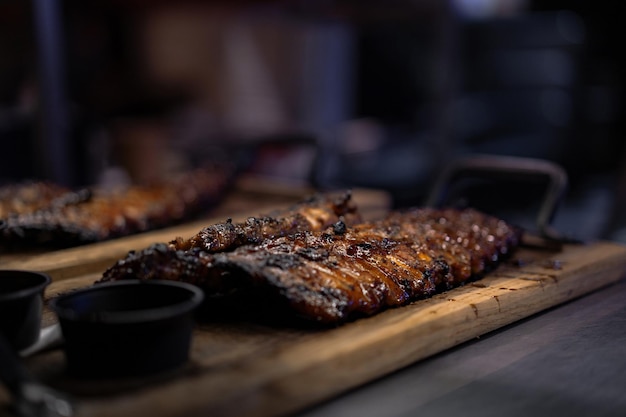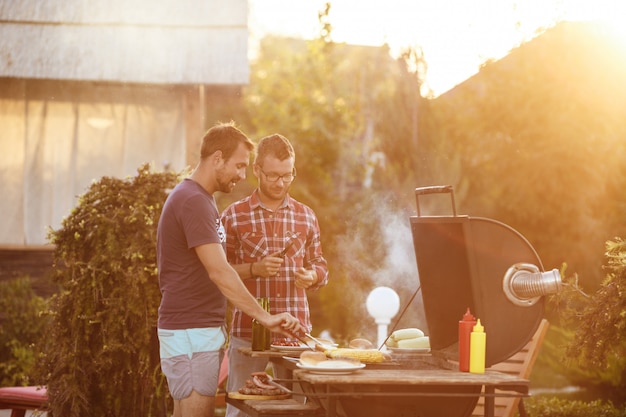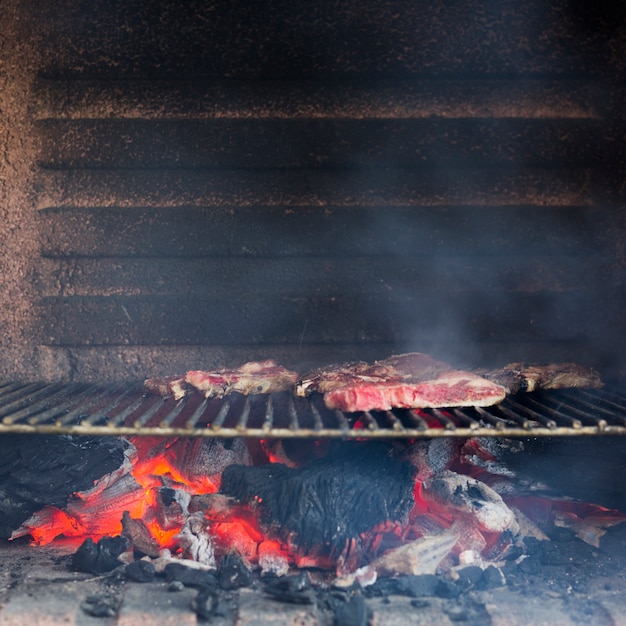What Liquid Do You Put at the Bottom of a Smoker?
If you’re an avid barbecue enthusiast or just starting to explore the art of smoking meat, you might have wondered about the importance of adding liquid to your smoker. The answer to the question of what liquid to put at the bottom of a smoker is not as straightforward as it may seem. While there are various options available, each with its own advantages and flavors, the choice ultimately depends on personal preference and the type of meat being smoked.
The Purpose of Adding Liquid to a Smoker
Before delving into the different liquids you can use in a smoker, it’s essential to understand why adding liquid is beneficial in the first place. The primary purpose of adding liquid is to help maintain a moist cooking environment, which can prevent the meat from drying out during the smoking process. Additionally, the liquid can enhance the flavor profile of the meat, infusing it with unique tastes that complement the smoke.
Water: The Classic Choice
One of the most common liquids used in smokers is plain water. It’s simple, easily accessible, and does an excellent job of keeping the cooking environment moist. Water produces steam as it heats up, creating a humid atmosphere that helps retain moisture in the meat and keeps it tender. This is especially important when smoking longer-cooking meats, such as brisket or pork shoulder, as they benefit from the prolonged exposure to moisture.
Enhancing Flavors with Broth or Stock
For those looking to add extra depth and flavor to their smoked meats, using broth or stock is a popular option. Whether it’s chicken, beef, or vegetable-based, broth or stock adds a savory element that complements the smoky flavors. You can experiment with different flavors by using pre-made or homemade broths and stocks, tailoring them to match the type of meat you’re smoking.
Tip: Consider using low-sodium or homemade broths and stocks to have better control over the overall saltiness of your final dish.
Adding Aromatics with Beer or Wine
If you want to elevate the flavors in your smoked meat while adding a unique taste profile, consider using beer or wine. Both alcoholic beverages can add depth, sweetness, and distinctive aromas to the meat. When using beer, opt for varieties that complement the meat, such as darker, richer brews for beef and lighter ones for poultry or fish. Wine, on the other hand, offers a wide range of options, allowing you to experiment and find flavor combinations that work best for you.
“Using beer or wine in a smoker adds another layer of complexity to the flavors and can turn a good barbecue into a memorable culinary experience.”
Other Liquids to Consider
While water, broth, stock, beer, and wine are popular choices, there are other liquids worth exploring. Some enthusiasts opt for fruit juices, such as apple or pineapple, to impart a subtle fruity sweetness to the meat. Others use vinegar-based marinades or citrus-infused water to enhance the acidity and brightness of their smoked dishes.
Tips for Using Liquid in a Smoker:
- Place a drip pan filled with the chosen liquid beneath the cooking grates to catch drippings and create steam.
- Keep an eye on the liquid level throughout the smoking process and replenish it as needed.
- Experiment with different combinations of liquids and seasonings to find your preferred flavor profiles.
- Consider using a disposable aluminum pan for easy cleanup.
In conclusion, the choice of what liquid to put at the bottom of a smoker depends on personal preference and desired flavors. Whether you opt for water, broth, beer, wine, or other liquids, the important thing is to maintain a moist cooking environment that enhances the taste and tenderness of your smoked meats. So, next time you fire up your smoker, don’t be afraid to get creative and experiment with different liquid options to take your barbecue game to new heights.
How do you prepare a BBQ for smoking?
Introduction
Smoking food on a barbecue can enhance flavors and create delicious, tender dishes. Whether you’re a seasoned pitmaster or new to smoking, proper preparation is key to achieving mouthwatering results. In this guide, we’ll walk you through the essential steps to prepare your BBQ for smoking.
Choose the Right BBQ
When it comes to smoking, using a charcoal or wood-fired BBQ is recommended. These types of BBQs provide the necessary heat and smoky flavor that you need for smoking food. Gas grills can also be used, but they may require additional steps to achieve the desired smokiness.
Gather Your Supplies
Before you start, make sure you have all the necessary supplies. You will need:
- A BBQ smoker box or aluminum foil pouch for wood chips
- Quality wood chips or chunks (such as hickory, apple, or mesquite)
- A reliable meat thermometer
- Heat-resistant gloves and long-handled tongs
- High-quality meats or vegetables to smoke
Prepare the BBQ
Follow these steps to prepare your BBQ for smoking:
- Clean the grill grates thoroughly to remove any residue from previous cooking.
- Fill a smoker box with your choice of wood chips or create an aluminum foil pouch for the chips.
- If using a charcoal BBQ, arrange the coals on one side of the grill, leaving an empty space for indirect cooking.
- If using a gas grill, preheat the grill with all burners on high for 10-15 minutes.
- Place the smoker box or foil pouch directly over the heat source.
Smoking the Food
Now that your BBQ is properly prepared, it’s time to smoke your food:
- Adjust the temperature to achieve the desired smoking range (225°F to 275°F).
- Place the meat or vegetables on the side of the grill away from the heat source for indirect cooking.
- Cover the BBQ and let the smoke work its magic. Avoid lifting the lid too often as it can cause temperature fluctuations and extend cooking time.
- Use a meat thermometer to monitor the internal temperature of the food and ensure it reaches the desired doneness.
Remember, patience is key when smoking food. It can take several hours for the flavors to develop and the meat to become tender.
Should I put a pan of water in my smoker?
Introduction
When it comes to smoking meat, many people wonder whether they should use a pan of water in their smoker. While there are differing opinions on the matter, understanding the purpose and potential benefits of using water in your smoker can help you make an informed decision.
The Role of Water in Smoking
Using a pan of water in your smoker can serve multiple purposes. Firstly, it acts as a heat sink, helping to stabilize the temperature inside the smoker by absorbing and distributing heat evenly. This ensures that the temperature remains consistent throughout the smoking process.
Secondly, water can help maintain a moist environment inside the smoker, which is particularly important when smoking meats that have a tendency to dry out. The moisture from the water can prevent the meat from drying out too quickly, resulting in juicier and more tender results.
Benefits of Using Water in Your Smoker
There are several benefits to using a pan of water in your smoker:
- Temperature Regulation: The water helps regulate the temperature by minimizing fluctuations, ensuring a more controlled smoking environment.
- Moisture Retention: The presence of water helps retain moisture in the meat, resulting in juicier and more flavorful smoked dishes.
- Enhanced Smoke Flavor: The water vapor released during the smoking process can help carry the smoke particles, intensifying the overall flavor of the meat.
Considerations When Using Water in Your Smoker
While using a pan of water in your smoker can provide several benefits, there are a few considerations to keep in mind:
- Cleaning: The water pan may require regular cleaning, as it can collect drippings and residue from the smoking process.
- Space Availability: Adding a water pan takes up space in your smoker, which may limit the amount of food you can smoke at once.
- Personal Preference: Ultimately, whether to use water in your smoker is a matter of personal preference. Some smokers choose to experiment with different methods to achieve their desired results.
“Using a pan of water in your smoker can be a great technique for maintaining steady temperatures and producing moist and flavorful smoked meats.”
Do you have to brine everything you smoke?
When it comes to smoking food, one common question that arises is whether or not everything needs to be brined before smoking. The answer, simply put, is no. While brining can certainly enhance the flavor and texture of certain meats, it is not a requirement for every item you wish to smoke.
Understanding Brining
Brining is a technique that involves soaking meat in a saltwater solution (sometimes with other flavorings) before cooking. This process helps to add moisture and flavor to the meat, especially when it comes to lean and tougher cuts. It also aids in tenderizing the meat, making it more succulent and juicy after smoking.
What to Brine
While brining is not necessary for all smoked foods, it can work wonders for certain items. Here are some examples:
- Poultry: Chicken, turkey, and other poultry benefit greatly from brining. The saltwater solution helps to prevent dryness, resulting in moist and flavorful meat.
- Pork: Brining pork can infuse it with delicious flavors and make it more tender. This is particularly beneficial for cuts like pork chops and loin.
- Seafood: Although seafood typically doesn’t require long brining times, a short brine can improve its taste and texture. Shrimp, salmon, and white fish are great candidates.
The Exceptions
There are certain types of meat that do not need to be brined before smoking. These include:
- Beef: Most cuts of beef, such as steaks and roasts, do not require brining. However, marinating can be a good alternative to enhance their flavor.
- Lamb: Similar to beef, lamb cuts do not typically benefit from brining. However, marinating can help elevate their taste.
Remember, every cook has their own preference when it comes to brining. So feel free to experiment and find what works best for you and your taste buds.
In conclusion, while brining can certainly enhance the flavor and texture of certain meats, it is not mandatory for all foods you wish to smoke. Poultry, pork, and seafood are great candidates for brining, whereas beef and lamb do not necessarily require it. Ultimately, it’s important to consider the specific meat and your personal preferences when deciding whether or not to brine before smoking.
Do you put wood chips directly on charcoal?
One of the most debated topics among barbecue enthusiasts is whether to put wood chips directly on charcoal or use a separate smoker box. The choice ultimately depends on personal preference, the type of grill you have, and the desired flavor profile you want to achieve.
Using wood chips directly on charcoal
Many seasoned grillers swear by the traditional method of placing wood chips directly on the charcoal. This allows the chips to ignite and release smoke as they burn, infusing your food with a rich and smoky flavor. It’s a simple and cost-effective way to add that authentic barbecue taste to your grilled meats and vegetables.
When using this method, it’s important to soak the wood chips in water for at least 30 minutes before adding them to the charcoal. This prevents them from burning too quickly and turning into ash before they have a chance to smoke.
Using a smoker box
If you prefer more control over the amount and intensity of smoke produced, using a smoker box is a popular alternative. A smoker box is a metal container that holds the wood chips and sits directly on top of the charcoal.
The advantage of using a smoker box is that it keeps the wood chips contained, preventing them from falling through the grates and allowing for a longer and more consistent smoke. Additionally, it makes it easier to replace or refill the wood chips during the cooking process without disturbing the charcoal.
Which method is best?
There is no definitive answer to this question as it largely comes down to personal preference. Some grillers may find that placing wood chips directly on the charcoal provides a more intense and immediate smoky flavor, while others prefer the control and convenience of a smoker box.
If you’re looking for a quick and easy way to add smoky flavor to your grilled dishes, using wood chips directly on charcoal is a tried and tested method that many grill masters swear by.
Ultimately, experimenting with both methods will help you determine which one suits your taste and grilling style best.
Remember, regardless of the method you choose, it’s important to use high-quality wood chips that are suitable for grilling. Different types of wood, such as mesquite, hickory, or applewood, will impart distinct flavors to your food, so don’t be afraid to try out different combinations to find your perfect smoky profile.
So, whether you decide to put wood chips directly on charcoal or use a smoker box, embrace the art of barbecue and enjoy the wonderful smoky flavors it brings to your meals.
Conclusion
By following these steps, you’ll be well on your way to preparing a BBQ for smoking. Experiment with different wood chip flavors and recipes to create your own signature smoked dishes. With a little practice and the right tools, you’ll soon be enjoying mouthwatering smoked BBQ like a pro.
While it is not mandatory to use a pan of water in your smoker, doing so can offer various advantages, including temperature regulation, moisture retention, and enhanced flavor. However, it is important to consider factors such as cleaning requirements and available space in your smoker. Ultimately, the decision should be based on your personal preferences and the desired outcome for your smoked dishes.



